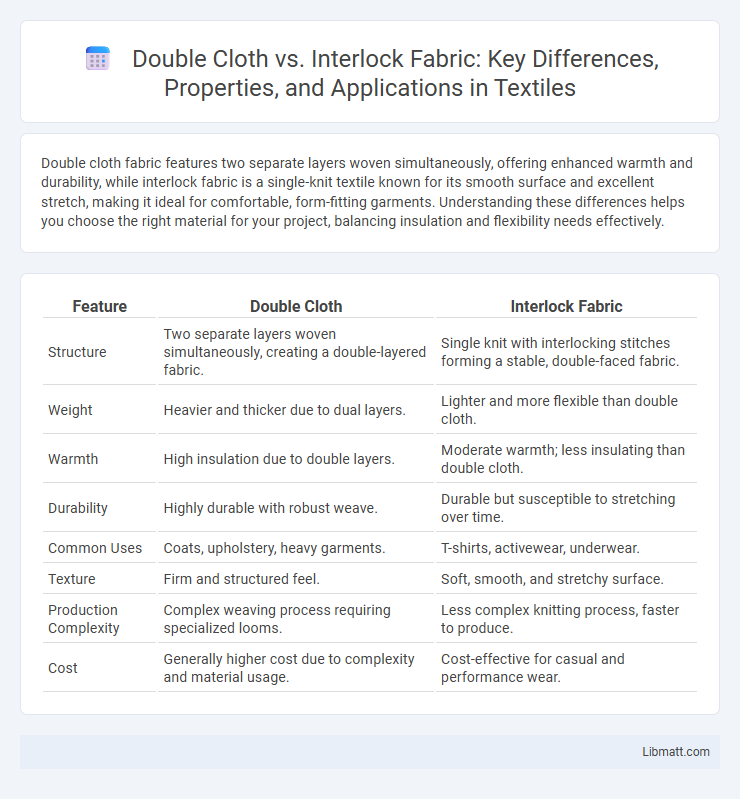Double cloth fabric features two separate layers woven simultaneously, offering enhanced warmth and durability, while interlock fabric is a single-knit textile known for its smooth surface and excellent stretch, making it ideal for comfortable, form-fitting garments. Understanding these differences helps you choose the right material for your project, balancing insulation and flexibility needs effectively.
Table of Comparison
| Feature | Double Cloth | Interlock Fabric |
|---|---|---|
| Structure | Two separate layers woven simultaneously, creating a double-layered fabric. | Single knit with interlocking stitches forming a stable, double-faced fabric. |
| Weight | Heavier and thicker due to dual layers. | Lighter and more flexible than double cloth. |
| Warmth | High insulation due to double layers. | Moderate warmth; less insulating than double cloth. |
| Durability | Highly durable with robust weave. | Durable but susceptible to stretching over time. |
| Common Uses | Coats, upholstery, heavy garments. | T-shirts, activewear, underwear. |
| Texture | Firm and structured feel. | Soft, smooth, and stretchy surface. |
| Production Complexity | Complex weaving process requiring specialized looms. | Less complex knitting process, faster to produce. |
| Cost | Generally higher cost due to complexity and material usage. | Cost-effective for casual and performance wear. |
Introduction to Double Cloth and Interlock Fabric
Double cloth features two separate layers of fabric woven simultaneously, offering thickness, warmth, and durability ideal for outerwear and upholstery. Interlock fabric is a type of knit with a smooth surface on both sides, known for its stretch, softness, and breathability, making it perfect for activewear and baby clothes. Your choice between double cloth and interlock fabric depends on whether you prioritize insulation and structure or flexibility and comfort.
Defining Double Cloth Fabric
Double cloth fabric consists of two distinct layers woven simultaneously on the loom, creating a thick, durable textile with enhanced insulation and texture. This unique construction results in a reversible material where each side can display different patterns or colors, offering versatility in design. Your choice of double cloth fabric provides superior warmth and structure compared to single-layer fabrics like interlock.
What Is Interlock Fabric?
Interlock fabric is a type of double-knit fabric characterized by its smooth surface and thickness, created by interlocking two layers of knit fabric. It offers excellent stretch and recovery, making it ideal for garments requiring comfort and durability, such as activewear and children's clothing. Your choice between double cloth and interlock fabric depends on the need for texture variation versus elasticity and softness.
Key Differences in Fabric Construction
Double cloth fabric consists of two layers woven simultaneously on a single loom, creating a thicker, reversible material with varying textures on each side, while interlock fabric is a type of knit made from two intermeshed knit layers, resulting in a smoother, stretchier surface. The core distinction lies in double cloth's woven structure offering enhanced durability and warmth versus interlock's knit construction providing superior elasticity and softness. Your choice depends on whether you prioritize the sturdy, layered feel of double cloth or the flexible, comfortable nature of interlock fabric.
Texture and Feel Comparison
Double cloth fabric features a thicker, more structured texture with a reversible design that provides warmth and durability, while interlock fabric offers a smoother, stretchier feel with a consistent surface on both sides. Double cloth's layered construction gives it a firm hand and excellent insulation, making it ideal for outerwear and heavier garments. Your choice depends on whether you prefer the cozy, substantial touch of double cloth or the soft, flexible comfort of interlock fabric.
Durability and Strength
Double cloth fabric offers superior durability and strength due to its construction of two separate layers woven simultaneously, creating a thicker and more robust material ideal for heavy-duty applications. Interlock fabric, characterized by its tightly knit single-layer structure, provides good strength with excellent elasticity and resistance to pilling but generally lacks the same level of durability as double cloth. The dual-layer composition of double cloth enhances its tensile strength and wear resistance, making it better suited for prolonged use under stress.
Versatility and Applications
Double cloth fabric offers exceptional versatility due to its dual-layer construction, making it ideal for outerwear, upholstery, and blankets that require added warmth and durability. Interlock fabric, characterized by its smooth, stretchy knit, excels in activewear, baby clothes, and casual garments where softness and flexibility are essential. Both fabrics provide distinct functional benefits that cater to diverse applications in fashion and home textiles.
Comfort and Breathability
Double cloth fabric offers superior comfort by combining two layers that provide warmth without excessive weight, enhancing breathability through natural air circulation between the layers. Interlock fabric is smooth and stretchy, delivering a soft, close fit that excels in moisture-wicking and breathability for activewear or everyday use. Your choice depends on whether you prioritize the insulating comfort of double cloth or the lightweight, breathable feel of interlock fabric.
Care and Maintenance Tips
Double cloth fabric requires gentle washing in cold water to preserve its layered structure and should be air-dried flat to avoid distortion. Interlock fabric benefits from machine washing on a gentle cycle with mild detergent and can be tumble dried on low heat to maintain its smooth texture. Both fabrics should be ironed on low settings to prevent damage and maintain fabric integrity.
Choosing Between Double Cloth and Interlock Fabric
Selecting between double cloth and interlock fabric depends on the desired texture and durability for specific applications. Double cloth offers a thicker, reversible structure with two distinct layers, ideal for outerwear and upholstery, while interlock fabric provides a smoother, stretchy surface perfect for activewear and seamless garments. Understanding the performance characteristics and end-use requirements ensures the best fabric choice for comfort and longevity.
Double Cloth vs Interlock Fabric Infographic

 libmatt.com
libmatt.com